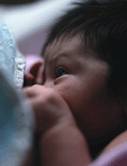

When babies come down with whooping cough, the odds are good that a sibling is the source, new research reveals.
That’s a change from years past, when mothers were most often the source. But the shift is not surprising, said study author Tami Skoff, an investigator with the U.S. Centers for Disease Control and Prevention.
It’s been clear for years that cases of whooping cough, or pertussis, are rising in the United States. In 2012, more than 48,000 cases were reported nationwide — the highest number since 1955, the CDC said.
And older children and teenagers are accounting for a growing proportion of cases.
A major reason for this is that throughout the 1990s, U.S. health officials switched from the traditional whooping cough vaccine to a newer one known as DTaP, out of concerns about rare neurological problems linked to the older vaccine, Skoff said.
The downside is that DTaP’s effects don’t last as long.
“The vaccine is very effective in the short term,” Skoff stressed. But the CDC estimates that whooping cough immunity slowly wanes each year after a child’s final dose, which is given around age 5.
If vaccinated children eventually catch the infection, they might not get very sick, Skoff noted.
But they can pass it on to young infants, who are at high risk of becoming severely ill. Of babies younger than 1 year who get whooping cough, half end up in the hospital, according to the CDC.
Newborns’ immune systems are too immature to receive the DTaP vaccine right away, so babies do not get their first dose until the age of 2 months. That’s followed by doses at 4, 6, and 15 to 18 months, with a final one between the ages of 4 years and 6 years.
Skoff said the best way to protect infants is for mothers to have a whooping cough booster shot — known as Tdap — during the third trimester of pregnancy.
That way, she explained, infants are born with some of mom’s immune system antibodies against the infection, which offers short-term protection.
A decade ago, experts were recommending a “cocooning” strategy for protecting babies, said Dr. Siobhan Dolan, a professor of obstetrics and gynecology at Montefiore Medical Center in New York City.
Cocooning means making sure family members and others caring for a young baby receive a Tdap booster.
“That was pretty effective, but not good enough,” said Dolan, who is also a medical advisor to the March of Dimes.
“Cocooning is difficult to achieve,” Skoff said. Plus, she added, infants can contract whooping cough from anyone, not just family members.
In the new study, the source of an infant’s infection was identified only 44 percent of the time, Skoff pointed out.
That’s why getting the booster during pregnancy — every pregnancy — is the best option, both she and Dolan said.
The current findings, published online Sept. 7 in the journal Pediatrics, are based on more than 1,300 infant whooping cough cases reported to health officials in seven U.S. states. When a source of the infection could be identified, it was usually an immediate family member: a sibling in almost 36 percent of cases, the mother in about 21 percent, and the father in 10 percent.
Right now, the CDC recommends that all Americans aged 11 and older have one Tdap booster shot. “Pregnant women are the only group who are advised to have more than one booster,” Skoff said.
Antibodies against whooping cough do not persist at a high level from one pregnancy to another, she noted, which is why women need the Tdap booster during each pregnancy.
Studies have shown the vaccine to be safe during pregnancy, Skoff said.
Dolan made the same point. “The notion that vaccinating during pregnancy will do harm is wrong,” she said. “It’s exactly the opposite. Vaccinating protects women and their babies.”
More information
The CDC has more on pregnancy and whooping cough.
Source: HealthDay
Copyright © 2024 HealthDay. All rights reserved.

Leave a Reply